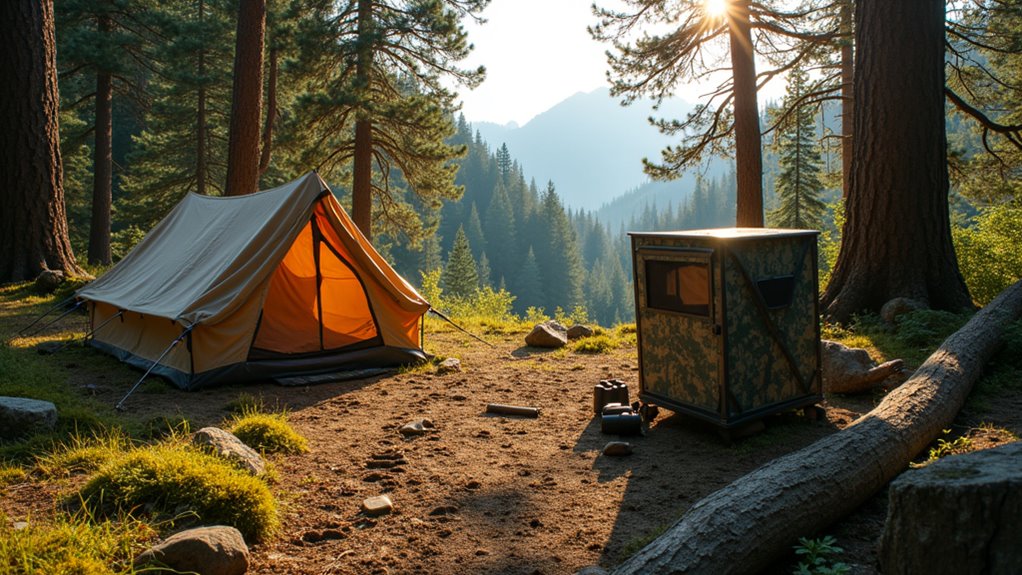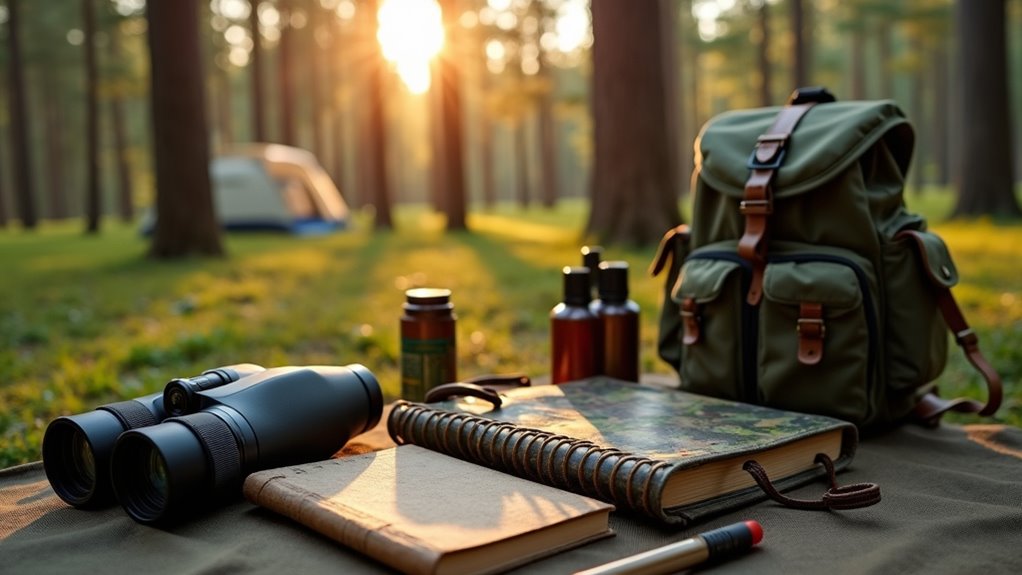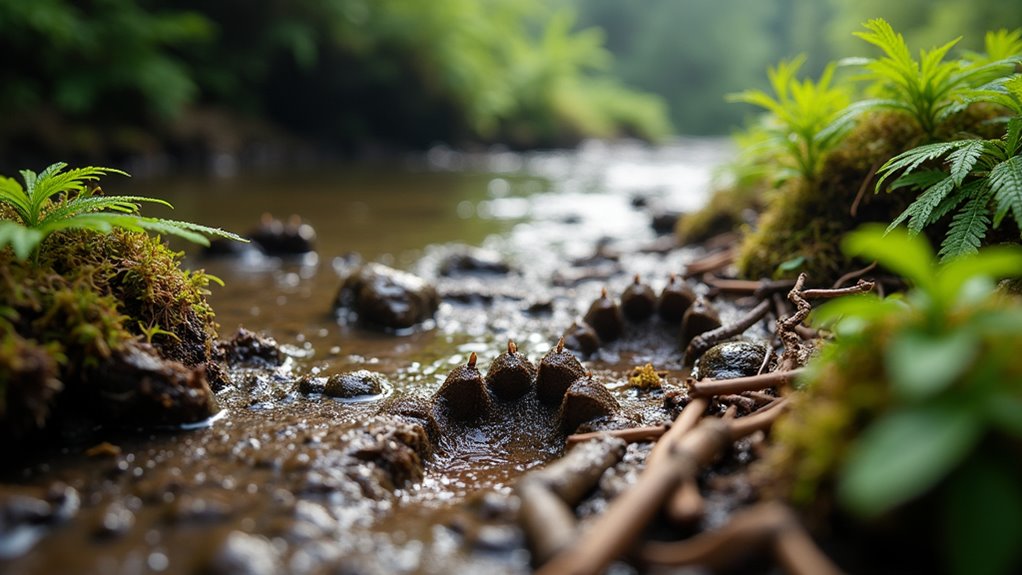Physical Address
304 North Cardinal St.
Dorchester Center, MA 02124
Physical Address
304 North Cardinal St.
Dorchester Center, MA 02124

Hidden wildlife secrets await forest campers who master strategic positioning—discover the simple techniques that transform ordinary trips into extraordinary encounters.
You’re probably setting up camp wherever looks convenient, but that approach won’t bring wildlife to you. The secret lies in strategic positioning—choosing spots near water sources or forest edges where animals naturally travel. You’ll need to think like the animals you want to observe, understanding their daily routines and preferred pathways. With a few simple techniques and minimal gear investment, you can transform an ordinary camping trip into extraordinary wildlife encounters that most campers never experience.

When you’re scouting for the ideal campsite, position yourself near natural wildlife corridors like streams, meadows, or forest edges where animals naturally travel. You’ll maximize viewing opportunities without expensive gear or guided tours.
Choose spots 50-100 yards from water sources – close enough to observe drinking animals but far enough to avoid disturbing them. Avoid camping directly on trails, as you’ll spook wildlife and disrupt their routines.
Look for elevated positions offering clear sightlines across clearings or valleys. Dawn and dusk activity increases dramatically in these migration zones.
Set up downwind from likely animal paths so your scent won’t alert them. Skip heavily trafficked campgrounds where human noise scares wildlife away. Remote, dispersed camping sites typically offer better wildlife encounters while saving campground fees.
Remember that campsite selection involves multiple factors beyond wildlife viewing, so balance your observation goals with safety, water access, and weather protection considerations.
Since most wildlife follows predictable daily rhythms, you’ll dramatically increase your viewing success by timing your observations around their natural activity peaks. Dawn and dusk are your golden hours – most mammals are crepuscular, meaning they’re most active during these twilight periods when temperatures are cooler and predators are less visible.
Plan your day around these prime times. Wake up early and position yourself near water sources or game trails before sunrise. You’ll save energy and see more animals than wandering around midday when most creatures are resting.
Different species have varying patterns. Birds are typically most vocal at dawn, while nocturnal animals like owls become active after sunset. Keep a simple log of your sightings to identify location-specific patterns and maximize future camping trips.
If you’re planning wildlife watching from waterways, consider whether renting or buying a used boat makes more sense for your specific trip duration and budget.

What separates successful wildlife watchers from disappointed hikers often comes down to having the right gear without breaking the bank. You don’t need expensive equipment to spot amazing wildlife during your forest camping trip.
Start with decent binoculars—8×42 models offer the best balance of magnification and light gathering without costing a fortune. A smartphone with a good camera works perfectly for documentation. Pack a small notebook and pen to record sightings and behaviors you’ll want to remember later.
Choose earth-tone clothing that won’t spook animals, and bring a lightweight camping chair for comfortable extended watching sessions. A red-filtered flashlight preserves your night vision while checking maps or notes.
Finally, download a reliable field guide app before you lose cell service—it’s cheaper than buying multiple guidebooks. Remember that maintaining safe distances from wild animals protects both you and the wildlife you’re hoping to observe.
Although the forest floor seems like nature’s obstacle course, you can master silent movement with simple techniques that cost nothing but practice. Place your heel down first, then roll to your toe while testing each step’s stability before transferring full weight. Avoid stepping on dry leaves, twigs, and loose rocks that’ll announce your presence to every animal within earshot.
Keep your knees slightly bent and take shorter steps to maintain better balance. Watch where you’re going three steps ahead, not just at your feet. Move during natural sound cover like wind through trees or flowing water nearby.
Stop frequently to listen and observe. Wildlife often freezes when they detect movement, so patience beats speed every time. After hours of patient tracking, reward yourself with a quick coffee using a portable espresso maker that won’t weigh down your camping gear.

When you can’t spot the animals themselves, their signs tell the complete story of their daily routines and favorite hangouts. Fresh tracks in mud or sand reveal size, direction, and timing.
Look for scat near trails—it indicates regular travel routes and diet habits. Scratched bark shows where bears marked territory or deer rubbed antlers.
Check for disturbed vegetation, bent branches, and worn paths through underbrush. Hair caught on thorns confirms which species frequent the area. Feeding signs like chewed nuts, stripped bark, or scattered feathers point to active hunting grounds.
Start tracking during early morning when dew highlights prints clearly. Carry a pocket field guide—they’re inexpensive and help identify unfamiliar markings. Practice reading signs around your campsite first before venturing deeper into wilderness areas.
After a long day of tracking and observation, ensure you have a comfortable camping pad for quality rest that will keep you alert for wildlife activity at dawn.
Once you’ve identified promising wildlife areas through tracking, your success depends heavily on how well you position yourself and blend into the surroundings. Choose spots downwind from anticipated animal paths—your scent will give you away faster than movement. Natural windbreaks like fallen logs or large rocks provide excellent cover without requiring expensive gear.
Wear earth-toned clothing you already own rather than buying specialized camo. Break up your silhouette by positioning yourself against varied backgrounds like bushes or tree trunks. Avoid ridge lines where you’ll be outlined against the sky.
Move slowly and freeze when animals appear. Quick movements trigger their flight response. Position yourself 15-20 feet from trails—close enough for good viewing but far enough to avoid spooking them. Patience beats expensive equipment every time. While forest camping focuses on concealment at ground level, outdoor enthusiasts seeking different challenges might consider glacier climbing adventures that require entirely different positioning strategies on vertical ice formations.

While positioning yourself for the best wildlife viewing experience, you must respect the animals and their habitat above all else. Keep your distance—use binoculars instead of getting closer for that perfect shot.
Don’t feed wildlife, as it creates dangerous dependencies and alters natural behaviors.
Stay on designated trails to minimize habitat disruption and avoid trampling sensitive vegetation.
Move quietly and speak in whispers. Sudden movements and loud noises stress animals and drive them away.
Pack out everything you bring in, leaving no trace of your visit.
Respect nesting areas and don’t approach young animals, as mothers may abandon offspring if they detect human scent.
Choose ethical tour operators who prioritize conservation over profit when booking guided experiences.
Consider incorporating wildlife viewing into your RV vacation planning to maximize your forest camping experience while maintaining these ethical practices.
Even with careful planning and respectful observation practices, you’ll occasionally find yourself closer to wildlife than expected. When this happens, your response can mean the difference between a memorable encounter and a dangerous situation.
Your split-second reaction when unexpectedly encountering wildlife can transform a peaceful moment into either a cherished memory or a perilous ordeal.
Essential Safety Protocols:
Remember that proper wildlife watching techniques during forest camping require patience and preparation to ensure both your safety and the animals’ well-being.
You’ll discover that 70% of wildlife encounters happen within the first two hours of dawn—timing that won’t cost you extra but dramatically improves your success rate. Remember, you don’t need expensive gear to become an effective wildlife observer; patience and respect matter more than your budget. Practice these techniques consistently, stay quiet, and you’ll transform ordinary camping trips into extraordinary wildlife adventures. Your dedication to ethical observation helps protect these incredible creatures for future generations.